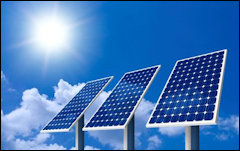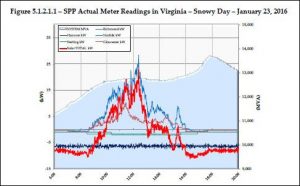Solar energy may account for a barely perceptible sliver of Dominion Virginia Power’s electric generating portfolio today, but the power company sees an increasing role for it in the future.
Even under its “low cost” scenario, Dominion foresees installing 1,000 megawatts of photovoltaic (PV) solar energy by 2041. Under a variety of other scenarios designed to meet the goals of the Clean Power Plan, which may or may not pass U.S. Supreme Court muster by 2041, solar could comprise between 2,100 megawatts and 8,000 megawatts of capacity. That compares to about 24,000 megawatts of current capacity across the utility’s power generation fleet.
Those numbers come from Dominion’s 2016 Integrated Resources Plan, a planning document filed last week in which the company lays out its expectations for electricity demand and its strategy for meeting that demand.
While the company expects a bigger role for sun-powered electric generation, the IRP raises concerns about the difficulty of integrating large amounts of solar, an inherently intermittent source of electric power, into a system that requires stability and predictability.
One commonly heard critique of solar is that it delivers electricity when the sun is shining, not when it is needed. (It is not “dispatchable.”) Therefore, the power company must either maintain backup power capacity or purchase electricity from elsewhere on the regional grid, both of which can be expensive. The 2016 IRP goes into great length elaborating upon a different problem: the difficulty of integrating large volumes of solar-generated electricity into the transmission and distribution grid.
In effect, says Dominion, the move to solar represents a paradigm shift in how electricity is generated and distributed. States the IRP:
All levels of the existing electric infrastructure, standards and operating protocols were originally designed for a dispatchable generation fleet (based on the market price as well as the topological condition of the electric network). This paradigm ensures system stability through control of frequency and voltage. PV generation systems, in contrast, only produce electricity when the sun is shining; therefore, energy output is variable and cannot be dispatched.
Conventional generating facilities are utility-scale, while solar panels installed by homeowners, businesses and public institutions bypasses the transmission grid and ties into local distribution circuits.
Therefore, the electric grid is evolving from a network where power flows from centralized generators through the transmission network and then to distribution systems down to the retail customer, into a network with generators of many sizes introduced into every level of the grid. The overall result is that traditional assumptions about the direction of power flows are no longer valid.
Fluctuations in electric power output cause variable power injections and losses on the grid, impacting frequency and voltage, which the industry must control within tight parameters. That’s not a problem when PV penetration is low, states the IRP, but it can be a problem when PV constitutes a larger percentage of power production. “On a multistate level, it is possible that the resulting sudden power loss from disconnection of distributed PV generation could be sufficient to destabilize the system frequency of the entire Eastern Interconnection.”
There are fixes for these problems — but they cost money. Static synchronous compensators (STATCOMs) can help prevent “voltage flicker” from solar power. Similarly, PV inverters, which invert the DC output of a solar PV facility into AC, continuously monitor the grid for voltage and frequency levels. High resolution meters, such as synchrophasors and digital fault recorder devices placed at the point of interconnection, support high-speed tripping to address power quality concerns.
So, how expensive would it be to upgrade the electric grid to accommodate a significantly higher contribution of solar power? The IRP alludes to a 2015 filing by Southern California Edison, estimating capital expenditures in the range of $1.4 billion to $2.5 billion to upgrade its current grid to facilitate integration of distributed solar.
The IRP also addresses energy storage technologies such as flywheels, batteries and compressed air energy storage. Of these, batteries are a potentially attractive option. States the IRP: “Batteries can be used to provide energy for power station blackstart, peak load shaving, frequency regulation services, or peak load shifting to off peak. … The primary challenge facing battery systems is the cost. Other factors such as recharge times, variance in temperature, energy efficiency, and capacity degradation are also important considerations for utility-scale battery.” Still, says the IRP, Dominion is “actively engaged” in evaluating the potential for energy storage technologies.
In conclusion, states the IRP, “Virginia’s potential maximum solar build out is relatively small compared to other states in the U.S. and countries in the world.”




